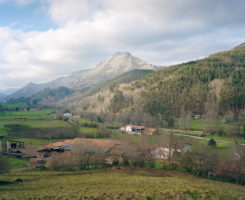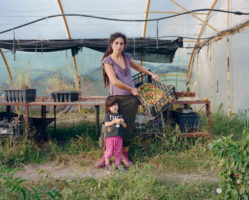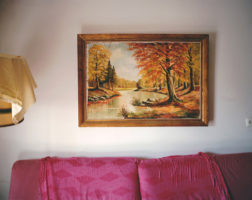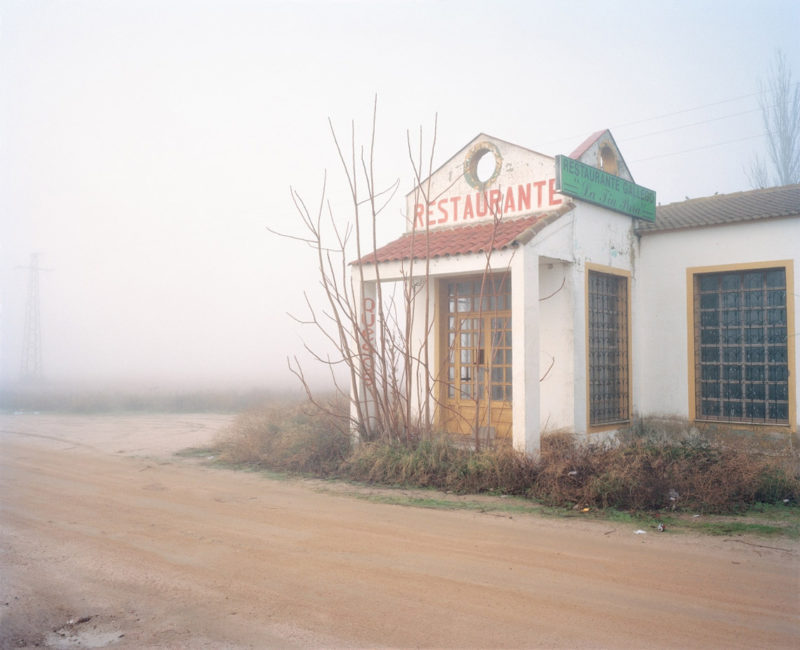What chance of utopian bliss we have, it is to be realized in caravans and self-made homes, lacking any of the comfort most of us are used to. At least that appears to be a message that runs through fairly large parts of contemporary photography. It is as if we just shed all the comfort, all the gadgets and trinkets, we could instantly revert back to the happier stage of life that we gave up some time in the past. This is a most curious message, and I’m wondering what it is rooted in.
Photography is the medium of nostalgia: any photograph by construction shows us the past. This is a time of nostalgia: regardless of where you look, we have become backwards looking, rehashing what was there in all kinds of ways, whether it’s music running through past trends at an increasingly frantic pace (I don’t know whether the 1980s are not yet cool, cool again, or already out of fashion again), Hollywood increasingly recycling its own past (badly, one might add), any period of the year now being part of some “history month,” or whatever else.
We can’t let go of the past because we can’t stand the present.
Is that what it is?
Even if it is not, how could photography not be part of the larger trend? On the surface, the medium is gripped by a massive wave of visual nostalgia (see my article The New Pictorialism). As I noted, that in itself is not necessarily a bad thing. But aesthetics aside, photographers usually serve as canaries in our cultural coal mine. Photography reflects our general concerns, and this is particularly true for what we could call “fine-art photography” (let’s just call it that: the photography made for photobooks and/or galleries/museums). This is the photography that at least on the surface has no obvious utility. It is made to exist in the form of luxury objects.
However, things aren’t quite so simple. Nobody needs a photobook or a print on the wall to survive. Fine-art photography has its own utility, a utility that exists beyond the worlds of regular commerce (that has no place for art) and of art commerce (that has no place for anything but art). Given we have become so obsessed with money, it’s hard to forget that what makes us think has immense utility, even if it’s hard to put a price tag on it. What reflects back to us what we are doing and what we want to be doing can be immensely useful for us.
This is where all those photographs of utopian paradises matter (beyond, needless to say, their own art spheres, which for the most part deal with artistic merit, something I’m ignoring here without wanting to imply that it doesn’t matter). These photographs present us with our general discontent with the world, by showing us another world.
Being presented with another, better world runs through the history of art, so we shouldn’t be surprised to encounter it (as far as I can tell being presented with another, worse world is limited to religious art, bad political propaganda, or Hollywood movies, there serving more specific purposes). If you think back to the 1960s, say, the idea of outer space, of space travel and rockets, created an abundance of imagery, which has become very “cool” looking again.
That’s the beauty of nostalgia: It’s easy to admire something that was popular in the past, because you already know a priori you’re in good company. In other words, you’re basically putting yourself into a company you admire. In the case of the 1960s space art, that would be the pioneering visionaries (this quickly falls apart, of course, because those forward-looking visionaries probably had very little patience for people so afraid of the future that all they can do is to look back).




What’s important in all of this is to realize that whatever utopia we are looking at, it’s all a fiction. Photography itself is a fiction (unfortunately one that comes in the disguise of a fact). Through its title, Juan Aballe‘s Country Fictions makes this clear. These landscapes, these people clinging to their very rudimentary homes, this idyllic painting on the wall – all of that, once depicted, becomes just a fiction.
A fiction just like, let’s say, what you see in a Mad Max movie, the difference being that everybody knows that the movie is a fiction, whereas it’s much harder to accept Country Fictions as such (its title notwithstanding).
As a whole, Aballe’s project shows us what we think of as the solution for our contemporary conundrum, in which the future is so incredibly uncertain, in which our parents appear to have held much more comfortable positions than we do: It’s going back to the past, to a simpler, better world, a world that in reality never existed (just open any history book and read up on the grim lives of people in a world where, to give just one example, the idea of childhood was quite a bit different).
But the beauty of a utopia, of course, is that it does not have to conform to any sort of reality. It’s a utopia after all. Country Fictions confronts us with our dreams, and it would be foolish to deny that we have them. The question then becomes what can we do to make sure that our dreams will be fulfilled? We probably shouldn’t expect things to look like in this fiction. But what could a world created from our own fictions look like?
What could we do so that we wouldn’t have to rely on the narcotic that is nostalgia any longer?
